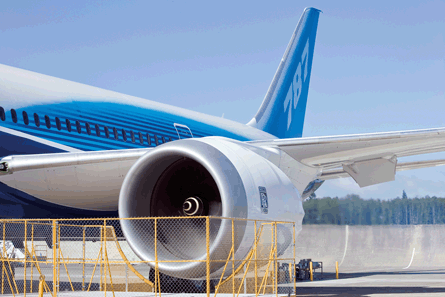Boeing has returned the last of its six dedicated 787 test aircraft to flying operations as it looks to complete the final 25% of conditions to achieve certification on Rolls Royce Trent 1000-powered aircraft by the US Federal Aviation Administration in the third quarter.
While the fleet of six test aircraft and one production aircraft have flown more than 2,700h since December 2009, Boeing says "at this point in testing, total hours are less important than getting through the conditions required" by the US Federal Aviation Administration.
The remaining 25% includes the extended twin-engine operations (ETOPS) and system functionality and reliability certification testing, which the company says will certify the 787 for long-range flying up to 330min from a suitable alternate airport.
CEO Jim McNerney says ETOPS will be a part of the basic certification of the 787. Boeing declines to specify a timeline for ETOPS testing, but says there is "no confusion" internally with the FAA as to when those tests will commence, although the airframer remains in what it considers perfectly normal "open discussion" with the US regulator regarding the "detailed test points" for ETOPS demonstrations.
 |
|---|
© Boeing |
Since mid-January, say programme sources, ZA001, the lead flight test aircraft, has devoted much of its flight testing to evaluating the response of the aircraft's primary flight control system under numerous failure scenarios for stability and control validation.
Aircraft ZA004 has concentrated on fuel system and fuel tank certification tests, including a 17 January fuel jettison test, while ZA002 has focused on certification of its high lift flap and slat system.
After completing nautical air mileage testing in Victorville, California, on the General Electric GEnx-1B engines, ZA005 conducted lapse rate takeoff testing, evaluating the 787's performance at varying altitudes and temperatures.
The trials took the composite jet from Albuquerque, New Mexico, starting on 22 January at 5,355ft to Aguadilla, Puerto Rico, at sea level up to 13,325ft in La Paz, Bolivia, returning to the US on 2 February.
ZA006 and ZA003 returned to flight status on 26 and 29 January, respectively, the last of the test fleet to do so following a halt to the certification campaign after the 9 November electrical fire aboard ZA002 in Laredo, Texas.
Additionally, the first production aircraft to fly, ZA102, has been conducting landing gear actuation tests following its 19 January first flight. The aircraft is expected to more fully participate in the flight portion of ETOPS testing.
First delivery, say industry sources, points to a September handover to Japan's All Nippon Airways, the first of 11 to 20 787s slated for delivery in 2011.
Source: Flight International























